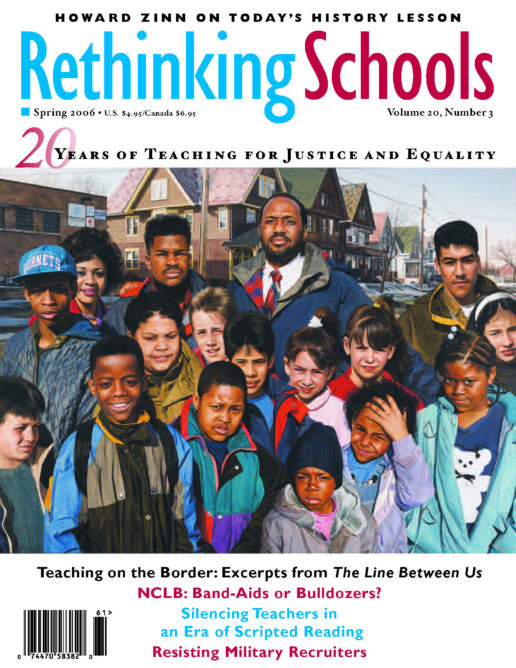Resources 20.3
Curriculum Resources
Enrique’s Journey:
The Story of a Boy’s Dangerous Odyssey to Reunite with his Mother
By Sonia Nazario
(Random House, 2006). 292 pp. $26.95.
Nazario tells the true story of Enrique, a teenager from Honduras, who leaves home to make the long trek to the United States to join his mother. This fills two important gaps in the immigration literature: using one boy’s story to highlight the tens of thousands of children who come to el norte every year, and focusing on Central American rather than only Mexican migrants. Alternately harrowing and inspiring, much of this book could be excerpted for use in middle and high schools, and would complement nicely the new Rethinking Schools book, The Line Between Us: Teaching About the Border and Mexican Immigration, described elsewhere in this issue.
A People’s History of Science: Minders, Midwives, and “Low Mechanicks”
By Clifford D. Conner
(Nation Books, 2005). 554 pp. $17.95.
Howard Zinn calls this book, “a delightfully refreshing new look at the history of science.” With chapters stretching from “Were Hunter-Gatherers Stupid?” to the up-to-date “The Scientific Industrial Complex,” the book is a blending of science and world history. It will be of special interest to science teachers who hope to convince students that “science” and “people” deserve to be in the same sentence.
*Sundown Towns:
A Hidden Dimension of Segregation in America
By James Loewen
(The New Press, 2005). 525 pp. $30.
In Sundown Towns, James Loewen (author of Lies My Teacher Told Me), deglorifies the North’s role in segregation. Too often, traditional treatments of U.S. history regard the South as racist and hostile, but the North as a safe space for African Americans. Yet from 1890 into the 1970s, whites-only communities from California to Connecticut were known as “sundown towns,” after the signs posted on city limits declaring the towns whites-only after dusk. In 1970, Illinois alone had 475 sundown towns. Loewen takes an in-depth look at segregation as a machine responsible for the denial of human rights. Loewen writes, “After all, after life itself, allowing someone to live in a place is perhaps the most basic human right of all.”
Reading and Writing the World with Mathematics: Toward a Pedagogy for Social Justice
By Eric Gutstein
(Routledge, 2006). 257 pp. $22.95.
Combining a deep understanding of critical teaching in the spirit of Paulo Freire with examples of teaching mathematics in inner-city middle schools in Chicago, Gutstein accomplishes something that most books published by academic presses fail to do. He blends theory and practice in a highly readable and useful volume. The book includes dozens of classroom lessons. This important contribution will teach and challenge mathematics teachers.
Speaking Out: Women, War, and the Global Economy
By Jan Haaken, et al.
(Ooligan Press, 2005). 98 pp. plus DVD. $19.95.
This creative and sophisticated package of lessons accompanies the DVD Diamonds, Guns, and Rice: Sierra Leone and the Women’s Peace Movement. The curriculum takes a broad look at Sierra Leone in the context of colonialism, civil war, and globalization, and weaves together diverse lessons including personal narrative, story, and role play. For high school and college. [Ooligan Press, Portland State University, P.O. Box 751, Portland, OR 97207-0751.]
*The Quotable Rebel: Political Quotations for Dangerous Times
Edited by Teishan Latner
(Common Courage Press, 2005). 400 pp. $20.
This book is a wide-ranging collection of quotes from radicals the world over on 54 topics. Latner’s volume is well-organized and useful — a rich source of inspiration for all of us, but also with countless curricular uses. Find wisdom in the words of people like Arundhati Roy, Eduardo Galeano, Tecumseh, Toussaint L’Ouverture, Malcolm X, Mark Twain, bell hooks, Vandana Shiva, and hundreds more.
Picture Books
Lakas and the Makibaka Hotel
By Anthony Robles, illustrated by Carl Angel
(Children’s Book Press, 2006). 32 pp. $16.95.
Based on the true story of tenants fighting eviction in a San Francisco apartment building, this bilingual English-Tagalog picture book brings a community struggle alive through a child’s eyes. The flamboyant, imaginative characters and the bright, engaging illustrations will pique students’ interest and allow an opening to discuss issues of justice and affordable housing.
Closet Ghosts
By Uma Krishnaswami, illustrated by Shiraaaz Bhabha
(Children’s Book Press, 2006). 32 pp. $16.95.
A delightful story depicting the fears and tribulations of a girl who doesn’t like her new home or school. Drawing on Hanuman, the mighty monkey hero from Indian Hindu mythology, the young girl finds comfort and strength as she overcomes her fears. Useful for discussion of change, fear, and moving to new neighborhoods and schools.
Policy Matters
*Why We Teach
Edited by Sonia Nieto
(Teachers College Press, 2005). 242 pp. $20.
Instead of the typical critique of schools and teachers, Why We Teach celebrates the craft of teaching. Written for and by teachers, Nieto features stories and analysis from 21 culturally and educationally diverse K-12 classroom teachers. Together, these pieces reveal the passion and hope that keep people in the classroom. Inspirational and informative, Why We Teach raises our understanding of the dedication that fuels people’s commitment to this profession.
*Un-Standardizing Curriculum: Multicultural Teaching in the Standards-Based Classroom
By Christine Sleeter
(Teachers College Press, 2005). 210 pp. $24.
The era of educational standards has challenged teachers everywhere who hope to pursue a rigorous multicultural curriculum as they respond to new mandates. Sleeter has provided a clear framework, illustrated with vignettes from the classrooms of eight teachers, on how to develop culturally relevant, academically challenging, and engaging curricula in a standards-based environment. An invaluable text for preservice and inservice programs.
Compiled by Jennifer Arrington, Bill Bigelow, Deborah Menkart, and Bob Peterson.
*Available from Teaching for Change www.teachingforchange.org

